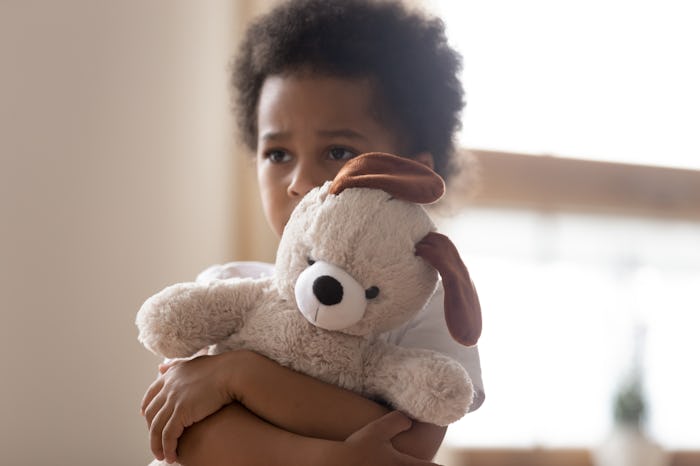Life

If Your Toddler Is Addicted To A Lovey, Here's What You Need To Know
It might not seem that a beaten-up blanket or a stuffed animal with some loose seams might be worth anything, but to your toddler, it just might mean the world. A lovey can play an important role in your child’s overall development and can become almost like an additional appendage, going everywhere your child does, from the car to the bed — even to the potty. But when your toddler is addicted to a lovey, is it necessary to stage an intervention — or just let the love affair continue?
If your little one has a lovey, there’s really not much reason for concern. In fact, 60% of children have an attachment to an object, as Live Science reported. “It’s not a bad thing for a child to have a lovey,” Rikki Goldenberg, a licensed mental health counselor in Boca Raton, FL, tells Romper. “It is a tangible object that helps them to always feel safe and secure.”
And that’s the secret to the allure of the lovey. Because it’s completely portable, it allows your child to feel safe and secure no matter where they are. “When a child takes their lovey with them, it helps them with the transition from an environment that they are comfortable in to a new environment that might be a little scary for them,” says Goldenberg. “It becomes the one thing that is consistent among all of the change that can be very overwhelming to a young child, especially one that may be experiencing fear or anxiety.”
Since a lovey offers the ultimate in self-soothing, it’s understandable that your child might be reticent to release their grip on it. And while other kids outgrow their need for it between the ages of 4 and 6, according to Parents, some kiddos still have a lovey well into their double digits. “A severe attachment to a lovey past the age of five might be a red flag,” Kimberly King, a child development expert and award-winning children’s author, tells Romper. “But ultimately, it’s up to your child when they’re ready to give it up.”
Depending on your child’s age, there might not be a reason to worry if your kiddo wants to lug around his lovey everywhere. Your bigger worry might be to pick a lovey that can easily be replaced if — and, realistically, when— you lose it. (Because it will happen.) “I highly suggest helping your child to choose a lovey that can be replaced when lost or damaged,” advises Goldenberg. “You want to be able to have several options for the lovey in case that specific item is no longer in stock and your child loses it.” Because seeing your child losing it over a lost lovey is truly heartbreaking.
To help break the lock your child's lovey has on him, you can implement some rules to start a super slow and smooth separation. For example, you might tell your child that the lovey can’t go everywhere with you, especially outside. “Restrict where you take it and schedule time for the lovey,” says King. “Try to keep the lovey at home or only in the car.” It will spare the shedding of tears — from both of you.
And if you find that the lovey is interfering with normal activities, or is causing problems, you might want to consider replacing the lovey with a fun new activity instead. “Instead of tucking in your toddler with the lovey and a kiss, you can read a book, give a big hug, or find something that will distract them,” says King. “Sometimes a little bedtime redirection is all your little one will need.”
A lovey is your child’s way of self-soothing, a way to feel comfortable. Eventually, every kid will outgrow their need for a lovey as they gain more independence. You never know — you might find yourself wistfully longing for those lovey (and lovely) days of your little one’s childhood.
Experts:
Rikki Goldenberg, licensed mental health counselor in Boca Raton, FL
Kimberly King, child development expert and award-winning children’s author